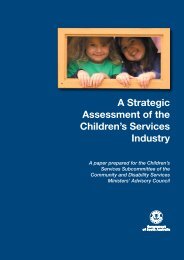Global Study On Child Poverty And Disparities (PDF) - Social Policy ...
Global Study On Child Poverty And Disparities (PDF) - Social Policy ...
Global Study On Child Poverty And Disparities (PDF) - Social Policy ...
You also want an ePaper? Increase the reach of your titles
YUMPU automatically turns print PDFs into web optimized ePapers that Google loves.
GLOBAL STUDY<br />
ON CHILD<br />
POVERTY &<br />
DISPARITIES<br />
<strong>Child</strong>ren and<br />
Development<br />
This section provides a broad background<br />
to understanding disparities in child<br />
well-being in Vanuatu. It describes the<br />
methodological approaches adopted in<br />
the <strong>Global</strong> <strong>Study</strong> on <strong>Child</strong> <strong>Poverty</strong> and <strong>Disparities</strong><br />
(UNICEF 2007). Next it reviews Vanuatu’s<br />
geography, political system, demographic<br />
characteristics and economic structure. This<br />
is followed by a discussion of income and<br />
expenditure inequality. The section concludes with<br />
an analysis of the role of government in Vanuatu<br />
and the components of social sector spending,<br />
as well as the important contribution made by<br />
international organisations and overseas aid<br />
agencies.<br />
Introduction<br />
Vanuatu and Pacific society generally have long<br />
been seen as having a traditional culture of caring<br />
and sharing within family and clan. Images of<br />
hunger and destitution and of absolute poverty<br />
frequently seen in other parts of the developing<br />
world have been largely absent in the Pacific.<br />
Vanuatu’s population, now almost 250,000 people,<br />
scattered across 65 islands, is largely rural (80<br />
per cent), and most households – including<br />
many in urban areas - rely on subsistence<br />
production (mainly agriculture and fishing) for their<br />
livelihoods. Households living on remote islands<br />
may have limited access to cash incomes, but<br />
usually have access to traditional land holdings for<br />
subsistence crops, and to the sea.<br />
Traditional family and kinship networks are strong<br />
in Vanuatu, as are other community institutions<br />
such as churches and non-governmental<br />
organizations (NGOs). While Ni-Vanuatu (the<br />
people of Vanuatu) might not be well off in<br />
financial or material terms, their strong family<br />
and community ties have traditionally provided a<br />
social safety net for the most disadvantaged and<br />
vulnerable. Indeed, in a participatory poverty and<br />
hardship assessment, poverty was defined as a<br />
state of “having nothing” (no gat samting), “being<br />
hopeless” and “struggling for survival,” and was<br />
largely viewed as not existing in Vanuatu (ADB<br />
2002).<br />
Hardship, however, is widely perceived to exist.<br />
Communities described hardship (Laef I had<br />
tumas) as “temporary and manageable life<br />
difficulties.” Hardship is characterized primarily<br />
by lack of or limited access to basic services<br />
such as education, health, good roads, and<br />
safe water supply (ADB 2002). The poorest<br />
households are likely to lack access to basic<br />
services, especially water and sanitation, if they<br />
are in the more remote parts of the country, away<br />
from urban amenities or in the squatter areas<br />
in the urban centres of Port Vila and Luganville.<br />
Limited income sources and unemployment were<br />
the most cited hardships in urban areas, while<br />
lack of or limited access to services and limited<br />
income sources were hardships in rural areas.<br />
Unemployed people, landless people, widows<br />
and single mothers, orphans, disabled and elderly<br />
16
















